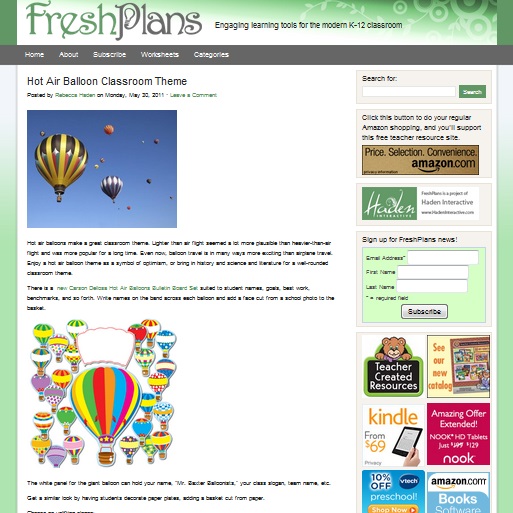Your cart is currently empty!

Selling at Your Blog
Blogs provide value for your business:
- Blogs drive traffic to different parts of your website.
- Your blog can show the world that you’re an expert in what you do.
- Blogs allow you to interact with your customers, and let your customers get to know you.
- Your blog gives your company a personal face, even if your business is only online.
- Since people use blogs as a source of information, your blog can add value to your website by supplying information your customers want.
- Blogs can lead to links for your website — including links that a strictly commercial site couldn’t get.
- Blogs allow you to rank for keywords that you otherwise wouldn’t show up for.
- Blogs keep your customers updated on news about your business.
Blogs also give you an opportunity to sell stuff. We’ve helped several stores and retailers reach customers and make sales through blogging. We’ve used blogging to sell products through Amazon’s affiliate program at our lab site. Not everyone sells products; your blog also helps you sell your services. You can sell a lot of stuff with a blog.
Yet people who use their blogs to sell things often fail. They decide that blogging really doesn’t work. Chances are, they’ve done it wrong.
Why is your audience at your blog in the first place?
Selling, from the point of view of retail blogging, can’t be something you do to people. People come to your blog of their own free will. They’re not coming to be sold to.
They’re probably not coming to look at ads, either. If your ads are good enough to be considered art, or to go viral at YouTube, that’s something else. But mostly, if you’re just saying “Buy my stuff!” people don’t want to see it.
On the other hand, people do want to buy things. Sometimes they even need to buy things. Customers may visit your blog to learn more about your product, your business, and why they should choose you over your competitor.
People also appreciate a deal, and maybe a discount code is enough to get them to pull the trigger and make that purchase they’ve been considering for the last couple of weeks.
They’ve come to your blog because they have some interest in the stuff you sell, so you don’t want to keep your goods a secret.
Don’t blog at your customer — blog for your customer
Look at private blogs; the blogs where people just write about what they find interesting and what they care about, without selling anything.
Those blogs write with excitement about the cool new phone they bought. They show pictures of the cute shoes they’re thinking about splurging on. They make lists of their favorite wines.
And their readers also go buy the phone, the shoes, the wines. They write about these things at their own blogs. It’s great marketing.
But they don’t have pictures of new phones every day, with no other content. They don’t show the same phone repeatedly with a new coupon code every day. They don’t harangue their readers into buying the phone, or push pop-up phone ads into their faces.
When you’re selling stuff with your blog, you need to show your products. You should take the opportunity to explain the great features of your product. Tell people where they can buy your products, e-commerce or brick and mortar. And you can certainly offer special deals.
An example using velocipedes
Imagine that you’re in the market to buy a new bicycle. You know bikes have two wheels, a seat, and some handle bars, but that’s where your knowledge of bicycles stops. However, you’d like to learn more about bicycles and make an informed decision.
In one store, you have an aggressive salesman: a real bull. He’s pushing you to buy the most expensive bike in the showroom, but doesn’t really answer any of your questions or provide any additional information apart from the price tag.
This salesman might make a few sales through brute force and persistence. However, customers may develop negative feelings about him or the store, and he may drive away more customers than he makes sales.
In a different store, you have a sales associate who is knowledgeable, honest, and truly helpful. He teaches you why some tires are wider than others, why some bikes have more gears, and how the geometry of a bike affects your comfort and performance. He provides you with some insider knowledge about bicycles, and he asks about your interests, what type of bike you’re looking for, and tries to help you find the bike that fits your needs.
Even if you don’t buy from that store today, you may decide to come back and buy a bike from them at another time. You will be more inclined to support them now and in the future, and you will also recommend that bike shop to your friends.
It’s the same for your blog. If you provide useful information, if you’re helpful and offer answers to questions that people ask, and if you provide value beyond a sales pitch, you’re more likely to make those sales.
An example using hot air balloons
The blog post you see a bit of above is on using a hot air balloon theme in the classroom. There’s a bulletin board set there, and people who click on it can buy it. It also has information on the history of hot air balloons and ideas on how to make effective use of the theme for back to school.
You know what? If you were a schoolteacher, you’d want to go read that lesson, even now that you know it was selling stuff.
Make your blog beautiful or useful or fun, and then go ahead and set out your wares. Your readers won’t mind. They’ll probably even buy.
by
Tags:

Leave a Reply